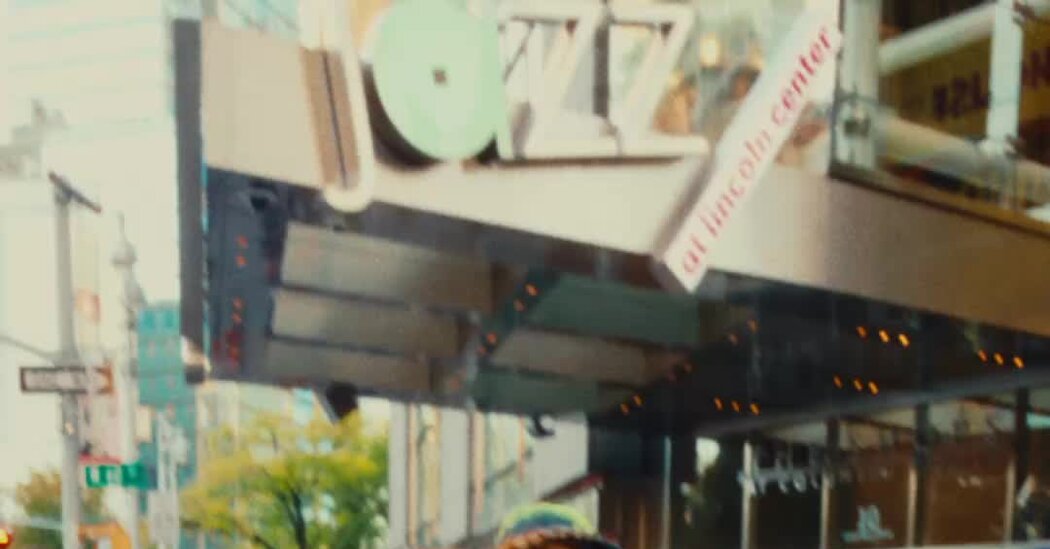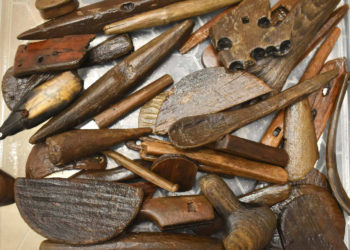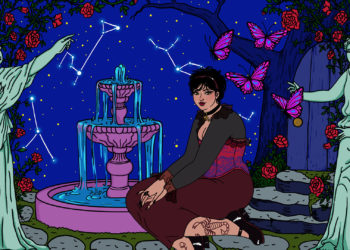Whole Foods was out of fresh croissants.
It was 4:30 p.m., just three hours before the curtain would rise on a revival of Puccini’s “La Bohème” at the Metropolitan Opera last week. For Rex Marquez — a tie-dye bucket hat pulled over his head, a red shopping cart that once belonged to his grandmother at his side — the grocery store’s lack of croissants was a bit of a crisis.
Marquez is a member of the small-props department of the Met. Before every performance of “La Bohème” — the company’s most frequently presented opera, sung over 1,400 times and counting — he sets out through the underground tunnels of Lincoln Center, emerges onto West 62nd Street and pushes his way through crowded sidewalks for a shopping expedition that will take him to four stops in about 90 minutes.
The Whole Foods on Columbus Circle is the second store on his tour. Inside, he moved deliberately through the aisles before reaching the bins that would normally hold the pastry he needed. Not today.
“There are no French croissants,” he said, looking at an empty bin. Franco Zeffirelli’s production of “La Bohème,” a popular fixture at the Met since 1981, has two members of the children’s chorus deliver a croissant, in a basket with bread, to Marcello and Rodolfo’s garret home in the Latin Quarter of Paris.
He looked across the store.
“There is an alternative,” he said, bearing down on a stack of prepackaged croissants, which he threw into the basket. That done, Marquez picked up baguettes, yogurt, salad and bagels before joining the long checkout line. The bill came to $70.97.
Marquez, 31, joined the Met five years ago and was assigned to front-of-the-house security — checking documents for Covid-19 immunization as patrons entered — before being promoted to this little-known but celebrated role backstage. You could argue that in “La Bohème,” Marquez’s work is only slightly less central to the performance’s success than the soprano Juliana Grigoryan’s singing as Mimì.
His assignment speaks directly to the specificity that defines Zeffirelli’s beloved production. Food is as central to its realism as the live donkey and horse that walk across the stage.
By now, Marquez has committed the production’s idiosyncratic — and, let’s face it, not exactly 19th-century Parisian — shopping list to memory. On his journey, he loaded his cart with four baguettes, 30 bagels, a 16-piece bucket of Popeyes fried chicken, three orders of French fries, three family-size bags of Double Stuf Oreos and one salad container of spring greens. For drinks onstage, he also gets a box of hibiscus tea, at Target, to be steeped overnight so it looks like red wine, and sparkling cider or ginger ale (depending on the cast’s preference) at Morton Williams, to be poured into Champagne bottles.
“The show has been played for many years,” he said, pausing at a stoplight on Columbus Avenue. “The menu has stayed the same. We keep it very conservative. We don’t explore.”
This is deadline work. With an eye on his watch, he was relieved when the clerk at Popeyes Louisiana Kitchen, ringing up his $87.07 order, announced that it would take only five minutes to fill. “That’s not bad,” he said. “I’ve seen it at 30.”
In truth, some of the details that Zeffirelli wanted for his show might not be appreciated by the audience in the Met’s immense theater. They come not for the food, but for Mimì and Rodolfo’s heartbreaking romance. Up in the Family Circle, the highest tier of seats, it is hard to discern that the waiter is bringing out real chicken, fries and salad to his table of diners. Or that the crema Musetta orders at Café Momus is actually plain whole-milk Stonyfield yogurt, which Marquez carefully sourced after poking around a shelf at Whole Foods.
“I think Zeffirelli wanted the singers to understand what it was like to be savoring real food,” said Fred Plotkin, who has written about opera and food, and who worked with Zeffirelli on “La Bohème” as a production manager at the Met, which has over 3,800 seats. “The audience might not see it. You may not be able to make out what the food is on the stage.”
Plotkin attended the latest “Bohème” revival’s opening and said that Freddie de Tommaso, the tenor playing Rodolfo, seemed not to be eating the baguette that Marquez had been holding under his arm a few hours earlier. “If he did eat anything,” Plotkin said, “it was just the tiniest bit because he didn’t want to get anything stuck in his throat.”
Regardless of whether the food gets eaten, or whether the audience appreciates the work behind the scenes, the preparation for each performance remains single-minded in its focus and intensity, from the shopping expedition to the backstage rush before the start of the show.
“Thirty minutes until curtain,” the stage manager announced on opening night, as Marquez slipped on black latex gloves to distribute those 30 bagels on three sticks. He then raced across the stage to drop it on a cart that would be rolled out for the cafe scene. “Where’s the lox!” someone yelled as Marquez sprinted through a crowd that included stage hands, performers (among them Lucas Meachem doing his warm-ups to sing Marcello), directors, technicians, animal handlers and Peter Gelb, the general manager of the Met.
Marquez returned to his preparation area, laying out plates for the chicken and French fries, which had been reheated, and salad. “A carb, a protein and a veggie,” he said before speeding out again to another corner of the stage to deposit the plates on a prop shelf, where a cafe waiter will retrieve them, removing the plastic wrap that is protecting the food, before taking it onstage to serve. “It’s like almost a little mini restaurant,” said Jason Hamilton, the opera’s properties master.
Then Marquez was back in his prep station, ripping open packages of Oreos to put into a bowl. “We are at eight minutes until the start of the first act,” the stage manager said.
“You have the crema?” Marquez shouted out. “Does it go next to the bowl of grapes?”
Realism, in this case, doesn’t necessarily equate to historical accuracy. There was no Popeyes chicken on the streets of Paris in the 1830s, and neither was there, in all likelihood, bagels. But these are Met traditions that go back so many decades that the reasons have been lost to time. Double Stuf Oreos? And isn’t fried chicken, with its persistent smell that lingers in elevators and hallways, not to mention crumbs and grease, the last thing you’d want onstage during an opera performance? (“I think it was most convenient,” Hamilton said. “I think there used to be a Kentucky Fried Chicken that was closer.”)
Any extra food does not go to waste. The biscuits that come with the Popeyes chicken are handed out to stagehands. The Oreos are in such high demand that Marquez keeps them under close watch until they are taken out onstage. There is rarely a bagel in sight as the Met closes up for the night.
Other operas have famous food scenes — “Don Giovanni,” “Hansel and Gretel,” “Tosca” — but in amount and sheer variety, nothing can match the Met’s “Bohème.”
Marquez has the job he does because, during those months working at the front of the house, he always had an eye on the show itself. “One day he came and asked, ‘Any chance I can get on the stage crew?’” Hamilton said. “He’s one of those guys I knew right away was right. He was the type that cared.”
Marquez calls himself a fan — a fairly recent one, but one nevertheless — of this art form. “Turandot,” another Puccini classic directed by Zeffirelli at the Met, he said, is his favorite. “I do love opera,” he said “Where I am now I am grateful. Five years ago I didn’t expect to be where I am now. “
Adam Nagourney is a Times reporter covering cultural, government and political stories in New York and California.
The post It’s Not ‘La Bohème’ Without a Trip to Whole Foods and Popeyes appeared first on New York Times.




